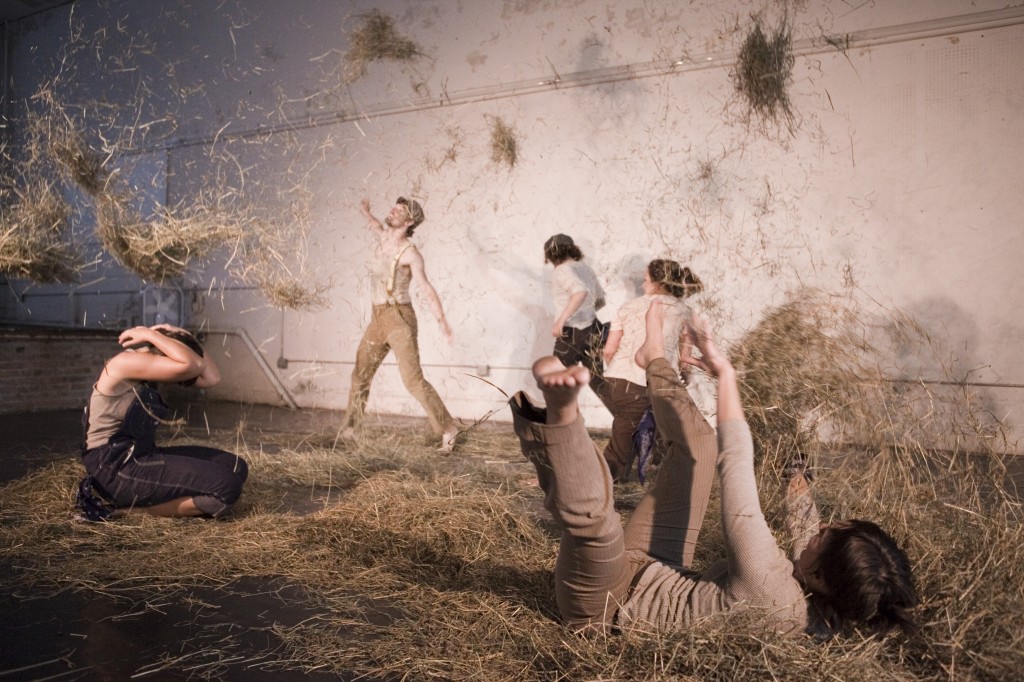by Lauren Warnecke

I was working tech on a show recently and the choreographer presented two pieces of modern dance. Before the show she gave a brief introduction to each piece, and explained that the first piece was a narrative and the second was a “pure movement” dance. She encouraged them to find the story within the first dance, while not toiling over the second; just to sit back and relax. It might be crucial to mention at this point that the audience consisted of 800+ physicists who inherently look for the greater meaning in everything. This got me thinking about how they might respond to the two pieces, both individually and as a whole experience.
There are conflicting opinions in modern dance with some choreographers gravitating toward stories and themes, and others making “dance for dance’s sake”. Many do some combination of the two, or abstract their work to the point that any allegorical relevance is beyond comprehension to the naked eye (this is where program notes come in handy). Some dances may rely on a simple adjective, feeling, or concept to generate the dance, where others may go to the extreme of being full-on story ballets that aren’t ballet. You might see this in choreographers like Mark Morris, while Trisha Brown runs a tight ship of process-driven, anti-thematic dances consisting of pure movement.
As a young choreographer, I felt the need to pick a camp, so to speak, and I responded really well to using a process to generate movement. So I decided that I would be one of those non-theme, whatever it is – it is, choreographers who cared little about the audience or their desire to draw meaning from a dance (a far cry from my artistic vision of today, but that’s not entirely the point here). I saw Trisha Brown’s dancers during my last semester of college and was brought to my feet, and to tears… not because the dances were so beautiful but because I knew and had studied the brilliance that went into their creation.
Conversely, even the shallowest of audience members like a good story – even something as simple as, “here is my dance about lions playing”. More recently, I’ve seen young and emerging choreographers who have typically presented meaningless (not in a bad way), emo-modern dance now choosing themes like The Wild West (The Dance Team’s Hub and Spoke and Striding Lion’s The Alamo), or re-imagining the great story ballets (Corpo Dance Company’s Coppelia). These stories, even shrouded in abstraction, give grounding to the dance that creates meaning and substance for audience members, regardless of how well-versed they are in watching dances. Even better, explaining the story in the program notes ensures that the audience is seeing what you intend them to see.
However….
Seeing Trisha Brown’s dances, or the unitard-clad, ripped technicians of the Merce Cunningham Company, gives one an appreciation for pure dance not because we understand, but because we don’t. There’s a respect that comes from the alienation of observing something that we can’t do. There might have been one year of my life that I could hold a full 160-degree tilt for one minute in a unitard, but certainly that’s not something that most of the general population can muster. So, we inherently admire and appreciate it. The same can be said for the great ballets. In spite of the narrative, there’s always room to pause for the lead ballerina to do a gaggle of fouette turns and the danseur to fit in a few switch leaps.
This begs the question: is it the artistry or the athleticism that we’re drawn to in dances, with or without themes? And, does it matter?
Maybe the answer lies somewhere in the middle. A loosely formed narrative or theme, with just enough abstraction to make it artsy, and a few high kicks just might be the way to go…. (?)

BIO: Contributor Lauren Warnecke, M.S., is a Chicago-based dance artist, educator, and writer. She trained at the Barat Conservatory of Dance before earning a BA in Dance at Columbia College Chicago. In 2009, Lauren completed her MS in Kinesiology at the University of Illinois at Chicago, with a concentration in Motor Control and Learning. Lauren is a Visiting Instructor for the department of Kinesiology and Nutrition at UIC, and teaches master classes and seminars in ballet, modern dance, creative movement, and dance pedegogy. She is certified in ballet by the Cecchetti Council of America and a member of the American College of Sports Medicine.
In addition to teaching at UIC, Lauren owns and operates Art Intercepts, under which she creates, informs, and writes about dance. The primary mission of Art Intercepts is to bridge the gap between the scientific and artistic communities to present programming that is informed, inventive, and evidence-based. Lauren is a freelance writer/blogger and maintains monthly columns at Danceadvantage.net and 4dancers.org. and is featured on a panel of nationally reputed dance writers at the 2012 Dance/USA conference. She also works periodically as a grant writer and production/stage manager for artists in the Chicago dance and performance community, and volunteers for initiatives encouraging Chicagoans to engage in local, sustainable, and active lifestyles. Lauren likes to hike, bake scones, and dig in the dirt.




